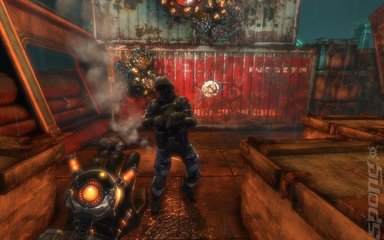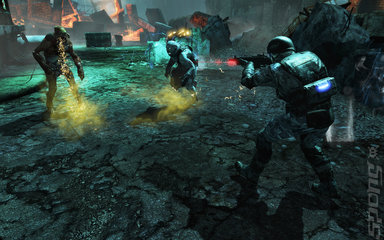Ever wanted to crash land on an island in the year 2010 and discover fluctuations in time between your era and 1950s America? Not really? Then spare a thought for poor Nate Renko, who not only has to suffer this fate on his lonesome but also has an army of Soviet Russians to deal with. Tasked with the mission of closing the time hole, it's a good thing he’s armed with a Time Manipulation Device (TMD), eh? Now the idea is starting to sound a little fun, right?
This is Raven Software’s latest action game – a story-driven shooter that draws references from a little bit of Cold War history and a lot of popular culture. Using the TMD, players can manipulate the scenery around them in various different ways, with the most common use I saw being advancing or rewinding time on an object or enemy. Doing the former solves puzzles like crumbling walls to let you progress, and the latter results in literally ageing your foe until they’re dust.
SPOnG had a quick chat with the game’s producer, Kekoa Lee-Creel, about the philosophy behind the title, franchise possibilities and how much the game is pushing the boundaries of console hardware.
SPOnG: There seems to be a lot of abilities you can use in Singularity, in regards to the TMD device. How have you structured the game so that you get to use the abilities in a cool way without overwhelming the player with all these moves you get to do?
Kekoa Lee-Creel: That’s a good question – in the demo we’ve actually showed a number of features, all mashed together so we can present the main abilities you can use throughout the entire game. In the final game the player will get these dished out in segments, so they will have to adapt to each mechanic as the game progresses.
For example, the player will start with the TMD and get the ageing functions first. They play with that for about thirty minutes or so, and then they’d be introduced to the next mechanic such as the Chrono-Light, which allows you to see objects out of time.
It also all seems overwhelming but once you get into it the controls are very intuitive and playing the game with all these different abilities is like second nature.
SPOnG: Seems like you will be able to use these abilities to overcome various puzzles too. Is there a risk of some kind of ‘Zelda Syndrome’ happening, where you pick up an ability, use it in that one level then never use it again after picking up the next one?
Kekoa Lee-Creel: There’s a balance that we’re striking here because the way the game is structured… during combat the player obviously has opportunity to use the abilities you’ve picked up. If they don’t want to, they can just run into a straightforward gunfight.
In puzzles, we’re building it so that each respective function builds off of the next. So, you saw me picking up an item using the Chrono-Stasis ability and then bringing the object back through time with the help of the Chrono-Light. You can now imagine that the next puzzle will require me to move from one time-space to another and use a new ability to help me through that.
It’s all layered, and the puzzles will use each mechanic respectively so that at the end you’re using all the mechanics to pass obstacles. In combat though, I think whatever your favourite way of approaching a scenario is, that’s what we’ll let you use – we want the player to have the choice in combat.
This is Raven Software’s latest action game – a story-driven shooter that draws references from a little bit of Cold War history and a lot of popular culture. Using the TMD, players can manipulate the scenery around them in various different ways, with the most common use I saw being advancing or rewinding time on an object or enemy. Doing the former solves puzzles like crumbling walls to let you progress, and the latter results in literally ageing your foe until they’re dust.
SPOnG had a quick chat with the game’s producer, Kekoa Lee-Creel, about the philosophy behind the title, franchise possibilities and how much the game is pushing the boundaries of console hardware.
SPOnG: There seems to be a lot of abilities you can use in Singularity, in regards to the TMD device. How have you structured the game so that you get to use the abilities in a cool way without overwhelming the player with all these moves you get to do?
Kekoa Lee-Creel: That’s a good question – in the demo we’ve actually showed a number of features, all mashed together so we can present the main abilities you can use throughout the entire game. In the final game the player will get these dished out in segments, so they will have to adapt to each mechanic as the game progresses.
For example, the player will start with the TMD and get the ageing functions first. They play with that for about thirty minutes or so, and then they’d be introduced to the next mechanic such as the Chrono-Light, which allows you to see objects out of time.
It also all seems overwhelming but once you get into it the controls are very intuitive and playing the game with all these different abilities is like second nature.
SPOnG: Seems like you will be able to use these abilities to overcome various puzzles too. Is there a risk of some kind of ‘Zelda Syndrome’ happening, where you pick up an ability, use it in that one level then never use it again after picking up the next one?
Kekoa Lee-Creel: There’s a balance that we’re striking here because the way the game is structured… during combat the player obviously has opportunity to use the abilities you’ve picked up. If they don’t want to, they can just run into a straightforward gunfight.
In puzzles, we’re building it so that each respective function builds off of the next. So, you saw me picking up an item using the Chrono-Stasis ability and then bringing the object back through time with the help of the Chrono-Light. You can now imagine that the next puzzle will require me to move from one time-space to another and use a new ability to help me through that.
It’s all layered, and the puzzles will use each mechanic respectively so that at the end you’re using all the mechanics to pass obstacles. In combat though, I think whatever your favourite way of approaching a scenario is, that’s what we’ll let you use – we want the player to have the choice in combat.




